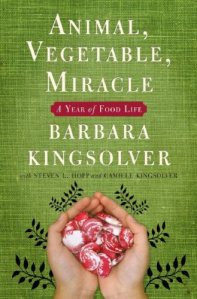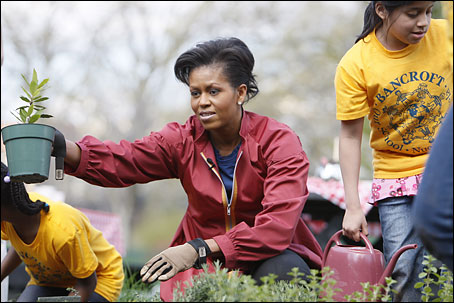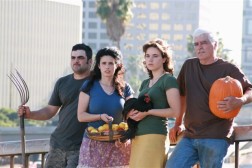 i recently picked up Barbara Kingsolver’s “Animal, Vegetable, Mircle,” though i have owned it for some months now (thank you vacation time). i am only through the first four chapters and i am almost exhausted – in a good way.
i recently picked up Barbara Kingsolver’s “Animal, Vegetable, Mircle,” though i have owned it for some months now (thank you vacation time). i am only through the first four chapters and i am almost exhausted – in a good way.
the jist – the author and her family spend a year eating locally (food off of their own land in rural Virginia, or from their neighbors), this is the story of their journey.
this book is packed with information and inspiration – i decided i couldn’t wait till i finished this book to tell you all about it. i have so many dog-eared pages and underlined sections that the final blog post would be impossibly long.
so i will share with you a few interesting things brought up in the book so far-
Barbara (along with her husband Steven and daughter Camille) seek out to inform people about the pros (and sometimes cons) of eating as locally as possible. here Steven explains the amount of oil consumption required for out-of-season foods can be curbed easily:
“A quick way to improve food-related fuel economy would be to buy a quart of motor oil and drink it. More palatable options are available. If every U.S. citizen ate just one meal a week (any meal) composed of locally and organically raised meats and produce, we would reduce our country’s oil consumption by over 1.1 billion barrels of oil every week…Small changes in buying habits can make big differences.”
the Kingsolver clan also tries to warn us about our dependence on single variety crops (mostly corn and soybeans), explaining that not only is diversity delicious and interesting but also almost necessary for human survival:
“The Irish once depended on a single [variety of] potato, until the potato famine rewrote history and truncated many family trees. We now depend similarly on a few corn and soybean strains for the majority of calories (both animal and vegetable) eaten by U.S. citizens. Our addiction to just two crops has made us the fattest people who’ve ever lived, dining just a few pathogens away from famine.”
last, but not least, Steven explains how a small farm is not only better for the environment, the community, and the health of our neighbors but is actually more profitable than big industrial farms:
“According to USDA records from the 1900s, farm less than four acres in size has an average net income of $1400 per acre. The per-acre profit declines steadily as farm size grows, less than $40 an acre for farms above a thousand acres. Smaller farms maximize productivity in three ways: by using each square foot of land more intensively, by growing more diverse selection of products suitable to local food preferences, and by selling more directly to consumers, reaping more of the net earnings. Small-farm profits are more likely to be sustained over time, too, since these farmers tend to be better stewards of the land, using fewer chemical inputs, causing less soil erosion, maintaining more wildlife habitat.”
subterranean books also reviewed with book a few months ago.
-clara



 i recently picked up Barbara Kingsolver’s “Animal, Vegetable, Mircle,” though i have owned it for some months now (thank you vacation time). i am only through the first four chapters and i am almost exhausted – in a good way.
i recently picked up Barbara Kingsolver’s “Animal, Vegetable, Mircle,” though i have owned it for some months now (thank you vacation time). i am only through the first four chapters and i am almost exhausted – in a good way.
 Homegrown
Homegrown